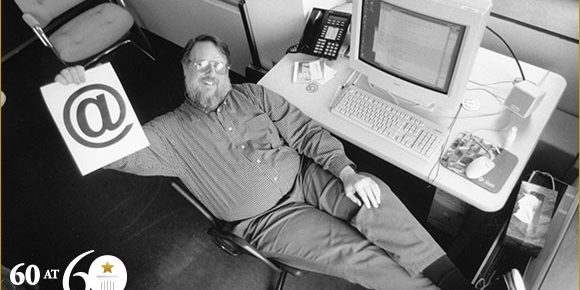This week is the 50th anniversary of the first email sent. For some of us, it feels as though emailing has always been around, perhaps we even take this easy way of communicating for granted. But this blog post is to remind you of the history of email, and how far we’ve come since 1969.
Who sent the first email and why?
Email was born from file transfers between users of Arpanet, the internal network of the Advanced Projects Research Agency in the USA. Before this, files could only be sent between different users on the same computer. The breakthrough was to realise that message inboxes were just files, so it was possible to send files across the network.
Ray Tomlinson invented email as we know it today in 1971. The content of his first email was short and sweet – it simply involved the letters of the first row of the keyboard – ‘QWERTYUIOP’. He used a network called ARPANET, which was also the basis for the internet. In fact, Ray Tomlinson later reflected on this, explaining that in the early 1970’s nobody wanted emails, nor did they see the point of them so long as they had telephones to communicate with others. Tomlinson invented the first email merely because ‘it seemed like a neat thing to do’.
Specific components that Tomlinson developed in order to send the first email are still used now and could even be described as fundamental to the 21st century email. The first is the famous ‘@’ sign. Tomlinson pragmatically said that it simply ‘made sense’ that the ‘@’ sign would be used after the user’s name to indicate their location. In addition, email fields were also developed by Tomlinson, including the from, subject and date fields.
How has emailing changed in the last 50 years?
When emails were first invented, they were wholly based around personal communication and could be compared to instant messaging – just as Tomlinson intended. Whereas, now, in the 21st century, emails are viewed in an entirely different light. In the early 2000s there was a huge shift from using emails for personal use to using emails for commercial use. This led to many spam emails being sent around which potentially threatened the practicality of emails for individuals around the world. Spam emails hit an all-time high in 2008, where 92.6% of total email traffic was spam mail. This has gradually improved over the years, where 50% of all emails in 2015 were spam. This has pushed businesses to be more sparing with the amount of emails they send out, and to target emails specifically to those potential customers who might take interest in them the most. However, unfortunately this has led to more and more people viewing emails as irrelevant – causing them to ignore or delete emails before even opening them. In fact, the key reason for people unsubscribing from emails is that they simply get too many. This contrasts greatly from pre 2000’s emailing, where individuals would read and reply to almost every single email they received due to most of them being personal.







